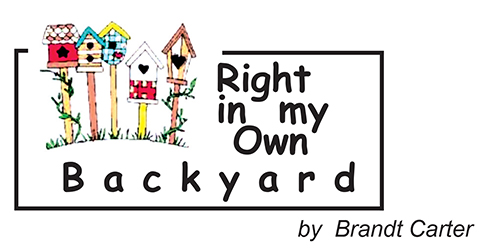
|
Broad Ripple Random Ripplings

The news from Broad Ripple
Brought to you by The Broad Ripple Gazette
(Delivering the news since 2004, every two weeks)

|
| Brought to you by: |

|

|

|

|

|

|
Converted from paper version of the Broad Ripple Gazette (v09n16)
Right in my Own Backyard - Urban Beekeeping - Part II - Guest Columnist Kathleen Blackham - by Brandt Carter
posted: Aug. 03, 2012

Urban Beekeeping- Part II
I would like to share my personal experience of keeping bees in the city. I set up my equipment and got my bees all with the help of my mentor. It was interesting to watch the bees take to their new home in my backyard, a city lot. It amazed me to watch them to orient themselves to my hive. They did that by flying around the entrance to the hive. This took a few hours. By the next morning, they had figured out their new home and were on their way to doing what they do best ― gathering nectar.
The frames that were in the hive bodies had some built-up comb, which meant that before much nectar could be deposited inside the hive, the bees had to finish building up the comb cells. As a result, that first year I was not able to harvest any honey. Unfortunately, winter brought challenges for the bees, and they did not make it through the winter. I have yet to understand the exact cause of this. There are so many factors that can affect bees in negative ways that it is impossible to identify the exact cause . . . at best it's just a guess.
The second year I was more diligent and ordered a "nuc." A nuc is small cardboard box with 6-10 frames of bees, a sealed brood and a queen (essential!). You just pull out the frames from your hives and replace them with the nuc frames. Once again those bees did not make it through the winter. I wasn't discouraged yet. I ordered two nucs the third year. I lost one over the winter and one survived ― finally. Yeah, a celebration! The fourth year, my mentor had some extra bees, and I was able to fill the void left by the demise of the one hive.
Now in my fifth year, I have three hives ― the strong hive and two additional hives created by swarms that were gathered by my friend. You see, when the hive becomes too crowded, the bees begin to grow a second queen. Once she is mature, part of the hive will leave with her and try to find a new home, freeing up space for the bees that remain in the hive. Typically, swarms are more prevalent during the spring. Swarms are "free" bees. You just have to figure out how to capture them.
This spring I was in my backyard when I looked up and saw the air filled with honey bees. I heard the amplified buzzing. I watched as the bees leaving the hive started gathering on a tree branch in my yard. As more and more bees gathered, their weight pulled the branch down. I called my friend with a plea for help. He told me if I lived out away from the city I could shoot the limb and have another person there to catch the bees. Well, I don't own a gun and didn't have anyone willing to stand below the branch to capture the bees. The branch where the bees had assembled was between 10-15 feet in the air. Within just a few minutes, however, the bees took off again and landed in my neighbor's tree. Ultimately, the bees disappeared. I'm hopeful that they found a home and are still gathering nectar.
A couple of summers ago I was able to harvest some honey and bottle it. The equipment to accomplish that task is expensive. This leads me to suggest finding a beekeeper with the extracting equipment and ask to use it. This is not a process for your kitchen or garage because the honey will somehow end up where you don't want it. It doesn't take long before you feel as though you have honey everywhere. I must also suggest that you wear old shoes for the process. This is the voice of experience; before I learned that lesson I was cleaning off sticky honey from my shoes for days. One last point: don't harvest all the honey the bees have made. They require at least 70 pounds of honey to get through the winter. You don't want to starve them.
My hope is that you may join me in harvesting Indianapolis honey. It is quite good. You and your friends will enjoy eating this liquid gold, and your yard will become more lush because of the pollination the bees contribute.
Check out backyardbees.psu.edu , a Penn State Extension 10 modules course via the internet. The course includes Bee Biology, Bee Behavior, Hive Management, Swarming, Equipment, Bee Products, and much more.
Guest columnist Kathleen Blackham is an urban neighborhood advocate. As an avid gardener, she enjoys honey from her beekeeping and collecting eggs from her chickens within just a few miles of Monument Circle.
Brandt Carter, artist, herbalist, and naturalist, owns Backyard Birds at 2374 E. 54th Street. Visit her web site www.feedbackyardbirds.com. Email your bird questions to Brandt@BroadRippleGazette.com
brandt@broadripplegazette.com

|

|

|
| Brought to you by: |

|

|

|
| Brought to you by: |

|

|

|
| Brought to you by: |

|

|

|
| Brought to you by: |


